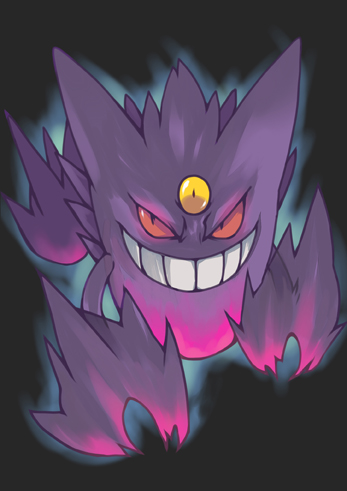We’ve all seen how Mega Evolution can drastically affect a Pokemon’s appearance, its stats, and even the Pokemon’s typing. With the classic Pokemon that’s the subject of this week’s post though, Mega Evolution causes another very drastic change in certain members of its species.
This is Mega Factor!
In this week’s edition of Mega Factor, we’re going to be covering an iconic Pokemon from the first generation games. Presenting the shadowy Pokemon known as Gengar.

The members of the Gengar evolution line were the first of their kind, as the three of them were the only Ghost-Type Pokemon to exist before Generation 2. To this day I’m sure each member of this family of ghosts is still a big favorite among fans even today. I’ve been more partial to Haunter ever since seeing that classic anime episode where Ash and Pikachu tried to get a Ghost Pokemon to fight the gym leader, Sabrina and ended up having that out of body experience. It’s actually rather ironic that Ash went to so much trouble to get a Ghost Pokemon to fight Sabrina, since in the actual games Gastly, Haunter and Gengar are practically worthless against Psychic-Types because of their Poison typing. I’m also quite fond of the talking Gastly from the episode where Ash and his friends visited a little village called Maiden’s Peak. Of course Gengar is the most iconic member of this evolution family, and it’s still apparently so powerful in the games that it didn’t really even need a Mega Evolution. Gengar still got a Mega Evolution anyway though, and it became even more terrifying because of it.
Normal Evolution: In order to obtain Gengar, players usually have to capture the first stage of this Pokemon’s evolution in the wild, that floating ball of spectral gas with a face known as Gastly. At level twenty-five, Gastly evolves into Haunter and gains those cool floating claws that helped to make it one of my favorites. Unfortunately, the only way to get Haunter to evolve into Gengar is to trade it. One option would be to trade Haunter with a friend who’s trying to get a Pokemon of his or her own to evolve through trading and then trade both of the Pokemon in question back. Another way would be to find a friend with another Haunter and trade both of them with each other.
Mega Evolution: After going through Mega Evolution, Gengar takes to the ground and becomes more like a shadow. It also gains some creepy purple lighting to make it look more frightening, along with a third eye on its forehead. In addition to the extreme change in appearance, Gengar’s Mega Evolution also gives a boost to its special attack and defense stats as well as its speed stat. Mega Gengar also gains a rather appropriate ability in the form of Shadow Tag, which prevents the opponent from switching their Pokemon out of battle. Of course gaining Shadow Tag as its ability means that Gengar loses its original Levitate ability, making it vulnerable to Ground-Type attacks.
The Shiny Factor: The concept of Shiny Pokemon is in my opinion one of the best gimmicks that Generation 2 introduced to the Pokemon games. While the alternate color scheme may not do anything to boost a Pokemon’s power in battle, they’re still neat to collect. Of course while there are Shiny Pokemon with dazzling alternate colorations that are worth all the trouble of collecting (i.e., the Red Gyarados from the Lake of Rage), there are other Shiny Pokemon that aren’t really worth the effort of catching because their alternate color scheme isn’t that much different from their normal coloration. The Shiny version of Gengar is an example of the latter. The thing is though that when a Shiny Gengar goes through Mega Evolution, its color scheme goes through a drastic change. It changes from its original bluish-black color to a stunning and very appropriate ghost-white. It’s little wonder that not too long ago, Nintendo did an event where players could download a special Shiny Gengar to their games.
That pretty much covers it for this week’s post. Next week, I’ll be covering one of the Starter Pokemon from the third generation games. Until next time, stay tuned.